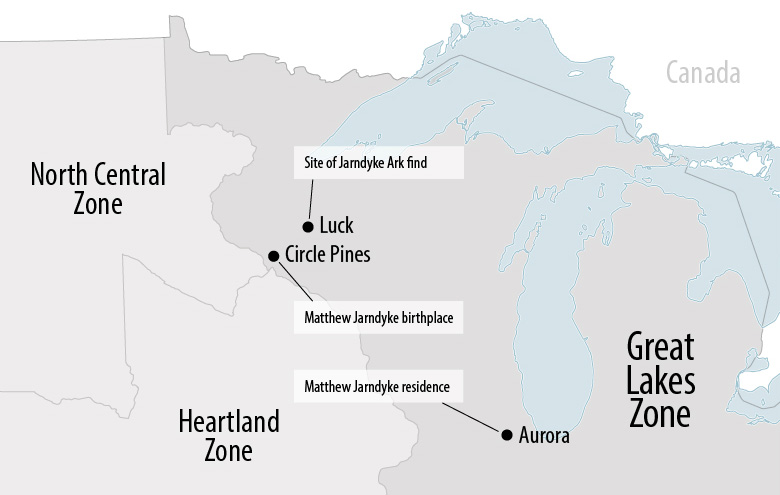Photo of the Jarndyke Ark when it was first uncovered in 1994.
Overview: The Jarndyke Ark
Overview: The Jarndyke Ark
Discovery
Within mere weeks of being found, the Jarndyke Ark forever changed the field of arkology, answering questions about life in the Zone system that had vexed arkologists for two decades.
Its discovery is credited to John and Rita Mackenbrock of Luck, Wisconsin, who struck the Ark while digging a hole in their backyard on September 13, 1994. After uncovering it with their bare hands, John Mackenbrock phoned the local AAS chapter in St. Paul, Minnesota, which dispatched a team to cordon the area and search for further artifacts. Nothing further was located.
Contents
As with other Arks found in the United States, the Jarndyke Ark appears to contain the personal effects of one person – in this case a man named Matthew Franklin Jarndyke. Contents of the Ark were sealed in a labeled plastic bag which housed a man’s wallet, an envelope of magazine clippings and other papers, a bankroll of cash, and a syringe used in emergency medicine.
What is known about Matthew Jarndyke
Map of locations relevant to the Jarndyke Ark.

Matthew Jarndyke.
Matthew Jarndyke was born in Circle Pines, a city near our St. Paul, Minnesota. Born in what is referred to in the Zones as the OE, Jarndyke would have lived through the transition between OE and NE, turning five-years old the year NE was declared.a
He was presumably drafted into the GLZ army on or before his 19th birthday, which other sources tell us is the age young men and women are typically conscripted into the armed forces or civil service in the Zone.b War raged between the GLZ and neighboring Heartland Zone (HLZ) from NE05 to NE07 at St. Louis before the GLZ withdrew its forces and razed the city in a sustained air campaign; artifacts in the Ark indicate Jarndyke saw heavy combat as part of a peace-keeping force along the Mississippi River.
His wartime experience left psychological scars that would set in motion Jarndyke’s quest to strike back at the Zone.c A letter found in the Ark’s envelope, presumably from Jarndyke’s girlfriend, mentions his plans to take violent action. This is corroborated by the clippings in the envelope, each of which mentions acts of domestic terror, and the folded map depicting a Zone-run penitentiary, which scholars assume was Jarndyke’s target.
Impact
The effect of the Jarndyke Ark on the world of arkology was nearly immediate. While identification cards and other personal effects in the Schott and Grunner Arks provided useful information about Zones,d,e the Jarndyke Ark’s contents captivated the world with its vivid depictions of global events.
The inclusion of an envelope of magazine clippings supplied details about not only the Great Lakes Zone, where Jarndyke lived, but in places as far-flung as the northern Pacific Zone (our Washington and Oregon states) and the Old Kingdom (Great Britain). These reports further knit together the North American and European arkology communities, which combined forces to shade a more global understanding of the arks.
The Jarndyke Ark was instrumental in the United Nations establishing the World Arkology Organization, which studies the role of ark artifacts in international relations.
a Most scholars agree that OE and NE refer to “Old Era” and “New Era,” respectively. There is no consensus, however, on how or even if these dates align with our own.
b Garfinkel C. The lamb feeds the snake: new perspectives on adolescence in the Zones. J World Arkology. 1999. 3(2):231-239.
c Brenton J, et al. The Jarndyke Ark, disaffection, and disaster. Liminal. 2002. 40:67-81.
d Mariuzza BH. Rousing the Sleeper: The Coming Conflict Between the Regions. N Am Arkology. 1982. 7(1);900-915.
e Leonard LS. Comment on “Significant new finds in the Cascade Range”. The Ark. 1990. 7;864-878.
Photo of the Jarndyke Ark when it was first uncovered in 1994.
Discovery
Within mere weeks of being found, the Jarndyke Ark forever changed the field of arkology, answering questions about life in the Zone system that had vexed arkologists for two decades.
Its discovery is credited to John and Rita Mackenbrock of Luck, Wisconsin, who struck the Ark while digging a hole in their backyard on September 13, 1994. After uncovering it with their bare hands, John Mackenbrock phoned the local AAS chapter in St. Paul, Minnesota, which dispatched a team to cordon the area and search for further artifacts. Nothing further was located.
Contents
As with other Arks found in the United States, the Jarndyke Ark appears to contain the personal effects of one person – in this case a man named Matthew Franklin Jarndyke. Contents of the Ark were sealed in a labeled plastic bag which housed a man’s wallet, an envelope of magazine clippings and other papers, a bankroll of cash, and a syringe used in emergency medicine.
What is known about Matthew Jarndyke

Map of locations relevant to the Jarndyke Ark.



Matthew Jarndyke.
Matthew Jarndyke was born in Circle Pines, a city near our St. Paul, Minnesota. Born in what is referred to in the Zones as the OE, Jarndyke would have lived through the transition between OE and NE, turning five-years old the year NE was declared.a
He was presumably drafted into the GLZ army on or before his 19th birthday, which other sources tell us is the age young men and women are typically conscripted into the armed forces or civil service in the Zone.b War raged between the GLZ and neighboring Heartland Zone (HLZ) from NE05 to NE07 at St. Louis before the GLZ withdrew its forces and razed the city in a sustained air campaign; artifacts in the Ark indicate Jarndyke saw heavy combat as part of a peace-keeping force along the Mississippi River.
His wartime experience left psychological scars that would set in motion Jarndyke’s quest to strike back at the Zone.c A letter found in the Ark’s envelope, presumably from Jarndyke’s girlfriend, mentions his plans to take violent action. This is corroborated by the clippings in the envelope, each of which mentions acts of domestic terror, and the folded map depicting a Zone-run penitentiary, which scholars assume was Jarndyke’s target.
Impact
The effect of the Jarndyke Ark on the world of arkology was nearly immediate. While identification cards and other personal effects in the Schott and Grunner Arks provided useful information about Zones,d,e the Jarndyke Ark’s contents captivated the world with its vivid depictions of global events.
The inclusion of an envelope of magazine clippings supplied details about not only the Great Lakes Zone, where Jarndyke lived, but in places as far-flung as the northern Pacific Zone (our Washington and Oregon states) and the Old Kingdom (Great Britain). These reports further knit together the North American and European arkology communities, which combined forces to shade a more global understanding of the arks.
The Jarndyke Ark was instrumental in the United Nations establishing the World Arkology Organization, which studies the role of ark artifacts in international relations.
a Most scholars agree that OE and NE refer to “Old Era” and “New Era,” respectively. There is no consensus, however, on how or even if these dates align with our own.
b Garfinkel C. The lamb feeds the snake: new perspectives on adolescence in the Zones. J World Arkology. 1999. 3(2):231-239.
c Brenton J, et al. The Jarndyke Ark, disaffection, and disaster. Liminal. 2002. 40:67-81.
d Mariuzza BH. Rousing the Sleeper: The Coming Conflict Between the Regions. N Am Arkology. 1982. 7(1);900-915.
e Leonard LS. Comment on “Significant new finds in the Cascade Range”. The Ark. 1990. 7;864-878.

